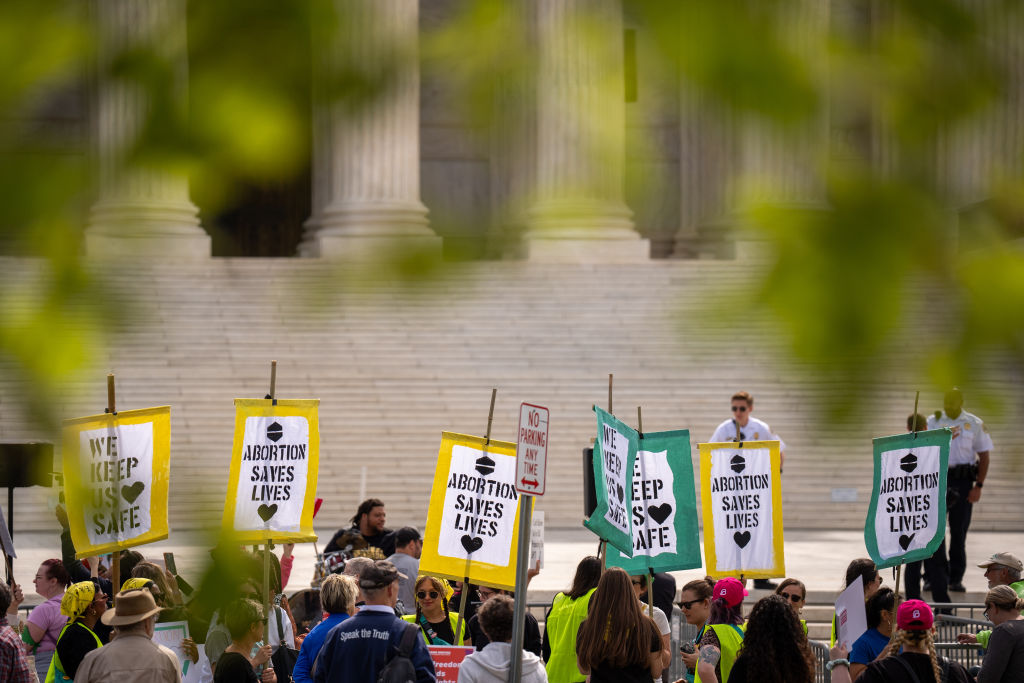
The specific issue before the Supreme Court on Wednesday in Moyle v. United States was whether the federal Emergency Medical Treatment and Labor Act (EMTALA) preempts Idaho’s law banning abortion.
- The Idaho law, also called the Defense of Life Act, imposes civil and criminal penalties if a physician performs an abortion, unless the physician uses “good faith medical judgment.” According to the law, the physician is to use the available facts known to them to ascertain whether or not an abortion is “necessary to prevent the death of the pregnant woman.”
- EMTALA, by contrast, requires a hospital to offer “necessary stabilizing treatment.” Sometimes, necessary stabilizing treatment involves abortion. And, EMTALA speaks directly to the question of pregnancy. The text states that an emergency medical condition is when “the absence of an immediate medical attention” could result in “placing the health of the individual (or, with respect to a pregnant woman, the health of the woman or her unborn child) in serious jeopardy.”
The narrowing of options for physicians in Idaho leaves them in a bind: Do you perform an abortion that could save a woman’s life or her organs, as dictated by EMTALA, or will you face penalties under Idaho law? This uncertainty means that the lives and organs of people who are pregnant are at risk, as they are denied care.
Oral arguments can sometimes reveal how the justices of the Supreme Court are approaching the issue at hand. The questions asked by the justices suggest the following:
1. A Lack of Clarity Under Idaho’s Law
Several of the justices seemed to question the premise of Idaho’s claim that they should not be required to follow EMTALA.
Many of their questions had to do with definitional issues. The lack of clarity was not only illustrated in the text but in the inability of the justices themselves to piece together the requirements for physicians to perform an abortion.
Notably, Justice Amy Coney Barrett seemed skeptical about the clarity of the Idaho law for physicians and the inability to resolve the complicated question of how to determine whether an abortion is necessary under Idaho law, and, relatedly, how a prosecutor would determine that the law had been broken.
Chief Justice John Roberts pressed Joshua Turner, the lawyer from Idaho, on what “good faith medical judgement” means in practice.
Their questions are important: If Coney Barrett and Roberts are convinced that the Idaho law is unclear, and that EMTALA offers a better chance of physician certainty and survival of the patient, the outcome of the case will protect the health of pregnant people, rather than undermine it.
2. Abortion as the Standard of Care
Justices Sonia Sotomayor and Elena Kagan’s questions made clear they both realize what is at stake: women’s lives, their organs and their reproduction.
Sotomayor began by questioning Turner with pointed questions: “If a woman is going to lose her reproductive organs unless she has an abortion, which happens in certain tragic circumstances, a doctor is supposed to provide an abortion. Isn’t that right?”
She pressed further: “Do you dispute that there’s a medical standard of care that when a woman is about to lose her reproductive organs unless she has an abortion, that doctors would not say that an abortion is the appropriate standard of care in that situation?”
This line of questioning puts the stakes of the preemption questions—which otherwise might seem arcane—on the table and into the conversation.
3. Acknowledgement of Fetal Personhood
Fetal personhood is also on the table. EMTALA, as described above, references the “unborn child.” This was particularly pronounced in Justice Samuel Alito’s question to Solicitor General Elizabeth Prelogar: “So, in that situation, the hospital must stabilize the threat to the unborn child. And it seems that the plain meaning is that the hospital must try to eliminate any immediate threat to the child, but performing an abortion is antithetical to that duty.”
The acknowledgement of fetal personhood through the invocation of “unborn child” is revealing: It suggests some justices are thinking about the future of fetal personhood and may even agree with the state of Idaho, that it is legitimate to consider the fetus when making decisions for the pregnant woman.
Of course, pregnancy is always taken into concern and after viability, the standard of care is delivery. But the problem is pronounced during the stage of pre-viability, where there is no “child” to save, or where the medical condition makes continuing the pregnancy impossible.
Prelogar clarified for Alito that in many emergency situations, there is no child to be saved and the refusal of care means that the patient’s conditions could deteriorate further, resulting in “tragedy upon tragedy.”
Tragedy might be the best word to describe the moment we are in: In a country with one of the most advanced medical systems, women and others with the capacity for pregnancy are left begging for appropriate medical interventions from politicians and judges in order to save their health, their organs and their lives.
After Wednesday’s oral arguments, it is tempting to entertain the possibility that the justices will mandate that doctors act to protect health. We should accept nothing less.
Up next:
U.S. democracy is at a dangerous inflection point—from the demise of abortion rights, to a lack of pay equity and parental leave, to skyrocketing maternal mortality, and attacks on trans health. Left unchecked, these crises will lead to wider gaps in political participation and representation. For 50 years, Ms. has been forging feminist journalism—reporting, rebelling and truth-telling from the front-lines, championing the Equal Rights Amendment, and centering the stories of those most impacted. With all that’s at stake for equality, we are redoubling our commitment for the next 50 years. In turn, we need your help, Support Ms. today with a donation—any amount that is meaningful to you. For as little as $5 each month, you’ll receive the print magazine along with our e-newsletters, action alerts, and invitations to Ms. Studios events and podcasts. We are grateful for your loyalty and ferocity.





